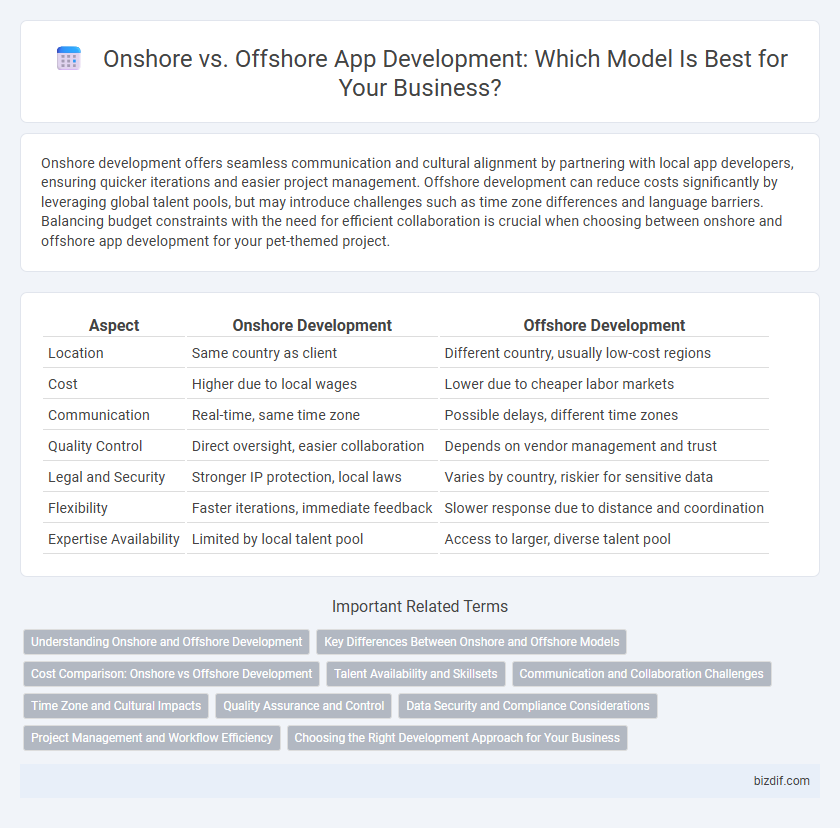Onshore development offers seamless communication and cultural alignment by partnering with local app developers, ensuring quicker iterations and easier project management. Offshore development can reduce costs significantly by leveraging global talent pools, but may introduce challenges such as time zone differences and language barriers. Balancing budget constraints with the need for efficient collaboration is crucial when choosing between onshore and offshore app development for your pet-themed project.
Table of Comparison
| Aspect | Onshore Development | Offshore Development |
|---|---|---|
| Location | Same country as client | Different country, usually low-cost regions |
| Cost | Higher due to local wages | Lower due to cheaper labor markets |
| Communication | Real-time, same time zone | Possible delays, different time zones |
| Quality Control | Direct oversight, easier collaboration | Depends on vendor management and trust |
| Legal and Security | Stronger IP protection, local laws | Varies by country, riskier for sensitive data |
| Flexibility | Faster iterations, immediate feedback | Slower response due to distance and coordination |
| Expertise Availability | Limited by local talent pool | Access to larger, diverse talent pool |
Understanding Onshore and Offshore Development
Onshore development involves collaborating with software developers located within the same country, ensuring easier communication, cultural alignment, and real-time collaboration. Offshore development refers to outsourcing app development tasks to teams based in different countries, often leveraging cost advantages and access to specialized skills. Choosing between onshore and offshore development depends on priorities such as budget constraints, time zone compatibility, and project complexity.
Key Differences Between Onshore and Offshore Models
Onshore development involves collaborating with software teams located within the same country, offering advantages like real-time communication, cultural alignment, and easier project management. Offshore development typically entails engaging with teams in different countries, providing cost savings, access to a larger talent pool, and the ability to scale resources quickly. Key differences between onshore and offshore models include time zone alignment, language proficiency, collaboration efficiency, and overall project control.
Cost Comparison: Onshore vs Offshore Development
Onshore development typically involves higher labor costs due to local market salaries which can significantly impact the overall project budget. Offshore development offers cost advantages by leveraging lower wages in countries such as India, the Philippines, or Eastern Europe, reducing expenses by up to 60%. However, cost savings must be balanced against potential challenges in communication, time zone differences, and project management complexities.
Talent Availability and Skillsets
Onshore development offers immediate access to local talent with specific industry knowledge and aligned communication styles, enhancing collaboration and project accuracy. Offshore development provides a broader pool of diverse skillsets, often at lower costs, but may face challenges with time zones and language barriers that impact real-time coordination. Companies prioritize onshore talent availability for projects requiring high security and rapid iteration, while leveraging offshore skillsets for large-scale tasks demanding specialized technical expertise.
Communication and Collaboration Challenges
Onshore development teams benefit from real-time communication and cultural alignment, reducing misunderstandings and fostering seamless collaboration. Offshore development often encounters time zone differences and language barriers, which can delay feedback cycles and complicate project coordination. Effective use of collaboration tools and clear documentation is essential to bridge these communication gaps in offshore projects.
Time Zone and Cultural Impacts
Onshore development offers seamless collaboration due to aligned time zones, reducing delays and enhancing real-time communication for app development projects. Offshore development presents time zone challenges that can delay feedback cycles but may be offset by cost advantages, requiring careful management of asynchronous communication. Cultural differences in offshore teams impact project workflows and communication styles, making cultural sensitivity and clear guidelines essential to maintain productivity and software quality.
Quality Assurance and Control
Onshore development teams typically offer higher quality assurance and control due to closer communication, shared time zones, and cultural alignment, which reduce misunderstandings and enable rapid issue resolution. Offshore development may present challenges in maintaining quality standards due to geographic and communication barriers, but leveraging robust QA frameworks and regular monitoring can mitigate these risks. Effective quality control in both models depends largely on clear documentation, stringent testing protocols, and continuous collaboration between stakeholders.
Data Security and Compliance Considerations
Onshore development offers enhanced data security and compliance benefits by adhering strictly to local regulations such as GDPR and HIPAA, ensuring sensitive information remains within national borders. Offshore development may pose risks due to varying international data protection laws and potential challenges in enforcing compliance standards. Prioritizing onshore teams can mitigate breaches and legal complications by leveraging familiar frameworks and direct oversight of security protocols.
Project Management and Workflow Efficiency
Onshore development offers superior project management through closer collaboration, real-time communication, and cultural alignment, resulting in faster decision-making and fewer misunderstandings. Offshore development can introduce challenges in workflow efficiency due to time zone differences and communication barriers, potentially causing delays and requiring more rigorous coordination. Effective workflow efficiency is often enhanced in onshore teams by shared work hours and face-to-face interactions, which streamline task management and agile methodology implementation.
Choosing the Right Development Approach for Your Business
Onshore development offers seamless communication and cultural alignment, enabling faster project iterations and reducing misunderstandings. Offshore development provides cost-effective solutions with access to a diverse talent pool, ideal for businesses aiming to maximize budget efficiency. Evaluating project complexity, budget constraints, and collaboration needs ensures the selection of the optimal development approach for successful app delivery.
Onshore development vs Offshore development Infographic

 bizdif.com
bizdif.com